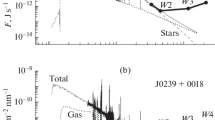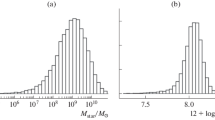Abstract
Integrated characteristics of a sample of 66 star-forming galaxies with extremely low oxygen abundances from the SDSS Data Release 14 are studied. The oxygen abundances were determined by the direct Te method for 42 galaxies with detected [O III] 436.3 nm emission lines and by the strong-line method for the remaining galaxies. Derived abundances 12 + log (O/H) fall within the 6.97–7.52 range and are, on average, four times lower than the corresponding values for a large comparison sample of compact star-forming galaxies from the SDSS. Stellar masses and Hβ luminosities for both samples were derived from SDSS spectra with a small spectroscopic aperture (2–3 arcsec in diameter). In order to determine their values for the entire galaxy, aperture corrections taking radiation outside the spectroscopic slit into account were introduced. Stellar masses and luminosities in the optical range are 100 times lower than the corresponding values for the galaxies from the comparison sample. At fixed values of luminosity and stellar mass, these galaxies have lower oxygen abundances in the oxygen abundance–luminosity and oxygen abundance–stellar mass diagrams than the galaxies from the main SDSS sample. This offset is likely caused by accretion of unenriched intergalactic gas, which reduces the oxygen abundance in the galactic interstellar medium. The majority of galaxies with extremely low oxygen abundances were detected in the mid-infrared range by the WISE space telescope. Color index W1 – W2, where W1 and W2 are the magnitudes at a wavelength of 3.4 and 4.6 μm, of these galaxies corresponds to the values typical for stellar emission and/or free-free ionized gas emission. The low ultraviolet luminosity, which is the main source of dust heating in star-forming galaxies, thus eliminates the possibility that warm and hot dust is present.



Similar content being viewed by others
REFERENCES
I. Yu. Izotova and Yu. I. Izotov, “Properties of star-forming galaxies in the mid-infrared range from the data obtained with the WISE space telescope,” Kinematics Phys. Celestial Bodies 35, 253–260 (2019).
B. Abolfathi, D. S. Aguado, G. Aguilar, et al., “The fourteenth data release of the Sloan Digital Sky Survey: First spectroscopic data from the extended Baryon Oscillation Spectroscopic Survey and from the second phase of the Apache Point Observatory Galactic Evolution Experiment,” Astrophys. J. Suppl. Ser. 235, 42 (2018).
P. A. R. Ade, N. Aghanim, C. Armitage-Caplan, et al., “Planck 2013 results. XVI. Cosmological parameters,” Astron. Astrophys. 571, 16 (2014).
R. J. Bouwens, G. D. Illingworth, P. A. Oesch, et al., “UV luminosity functions at redshifts z ~ 4 to z ~ 10: 10,000 galaxies from HST legacy fields,” Astrophys. J. 811, 33 (2015).
B. Ekta and J. N. Chengalur, “When are extremely metal-deficient galaxies extremely metal deficient,” Mon. Not. R. Astron. Soc. 406, 1238–1247 (2010).
L. Girardi, A. Bressan, G. Bertelli, and C. Chiosi, “Evolutionary tracks and isochrones for low- and intermediate-mass stars: From 0.15 to 7 M☉, and from Z = 0.0004 to 0.03,” Astron. Astrophys. Suppl. Ser. 141, 371–383 (2000).
R. L. Griffith, C.-W. Tsai, D. Stern, et al., “WISE discovery of low-metallicity blue compact dwarf galaxies,” Astrophys. J. 736, L22 (2011).
N. G. Guseva, Y. I. Izotov, K. J. Fricke, and C. Henkel, “New candidates for extremely metal-poor emission-line galaxies in the SDSS/BOSS DR10,” Astron. Astrophys. 579, 11 (2015).
N. G. Guseva, Y. I. Izotov, K. J. Fricke, and C. Henkel, “Searching for metal-deficient emission-line galaxy candidates: The final sample of the SDSS DR12 galaxies,” Astron. Astrophys. 599, 65 (2017).
A. S. Hirschauer, J. J. Salzer, E. D. Skillman, et al., “ALFALFA discovery of the most metal-poor gas-rich galaxy known: AGC 198691,” Astrophys. J. 822, 108 (2016).
Y. I. Izotov, F. H. Chaffee, C. B. Foltz, et al., “Helium abundance in the most metal-deficient blue compact galaxies: I ZW 18 and SBS 0335-052,” Astrophys. J. 527, 757–777 (1999).
Y. I. Izotov, N. G. Guseva, K. J. Fricke, and C. Henkel, “Multi-wavelength study of 14 000 star-forming galaxies from the Sloan Digital Sky Survey,” Astron. Astrophys. 561, 33 (2014).
Y. I. Izotov, N. G. Guseva, K. J. Fricke, and P. Papaderos, “SBS 0335-052E+W: Deep VLT/FORS+UVES spectroscopy of the pair of the lowest-metallicity blue compact dwarf galaxies,” Astron. Astrophys. 503, 61–72 (2009).
Y. I. Izotov, N. G. Guseva, K. J. Fricke, and C. Henkel, “Low-redshift lowest-metallicity star-forming galaxies in the SDSS DR14,” Astron. Astrophys. 623, 40 (2019).
Y. I. Izotov, N. G. Guseva, and T. X. Thuan, “Green pea galaxies and cohorts: Luminous compact emission-line galaxies in the Sloan Digital Sky Survey,” Astrophys. J. 728, 161 (2011).
Y. I. Izotov, V. A. Lipovetsky, F. H. Chaffee, et al., “SBS 0335—052, a probable nearby young dwarf galaxy: Evidence pro and con,” Astrophys. J. 476, 698–711 (1997).
Y. I. Izotov, T. X. Thuan, and N. G. Guseva, “Hunting for extremely metal-poor emission-line galaxies in the Sloan Digital Sky Survey: MMT and 3.5 m APO observations,” Astron. Astrophys. 546, 122 (2012).
Y. I. Izotov, T. X. Thuan, and N. G. Guseva, “J1234+3901: An extremely metal-deficient compact star-forming dwarf galaxy at redshift 0.133,” Mon. Not. R. Astron. Soc. 483, 5491–5498 (2019).
Y. I. Izotov, T. X. Thuan, N. G. Guseva, and S. E. Liss, “J0811+4730: The most metal-poor star-forming dwarf galaxy known,” Mon. Not. R. Astron. Soc. 473, 1956–1966 (2018).
V. Khaire, R. Srianand, T. R. Choudhury, et al., “The redshift evolution of escape fraction of hydrogen ionizing photons from galaxies,” Mon. Not. R. Astron. Soc. 457, 4051–4062 (2016).
T. Lejeune, R. Buser, and F. Cuisinier, “Standard stellar library for evolutionary synthesis. I. Calibration of theoretical spectra,” Astron. Astrophys. Suppl. Ser. 125, 229–246 (1997).
J. Lequeux, M. Peimbert, J. F. Rayo, et al., “Chemical composition and evolution of irregular and blue compact galaxies,” Astron. Astrophys. 80, 155–166 (1979).
R. Maiolino and F. Mannucci, “De re metallica: The cosmic chemical evolution of galaxies,” Astron. Astrophys. Rev. 27, 3 (2019).
M. Ouchi, B. Mobasher, K. Shimasaku, et al., “Large area survey for z = 7 galaxies in SDF and GOODS-N: Implications for galaxy formation and cosmic reionization,” Astrophys. J. 706, 1136–1151 (2009).
B. E. Robertson, R. S. Ellis, S. R. Furlanetto, and J. S. Dunlop, “Cosmic reionization and early star-forming galaxies: A joint analysis of new constraints from Planck and the Hubble Space Telescope,” Astrophys. J. 802, L19 (2015).
B. E. Robertson, S. R. Furlanetto, E. Schneider, et al., “New constraints on cosmic reionization from the 2012 Hubble Ultra Deep Fields,” Astrophys. J. 768, 71 (2013).
J. H. Wise and R. Cen, “Ionizing photo escape fractions from high-redshift dwarf galaxies,” Astrophys. J. 693, 984–999 (2009).
ACKNOWLEDGMENTS
We thank the anonymous reviewer for useful remarks. Data provided by Wide-Field Infrared Survey Explorer (WISE), Galaxy Evolution Explorer (GALEX), and Sloan Digital Sky Survey (SDSS) were used in this study. WISE is a joint project of the University of California, Los Angeles, and the Jet Propulsion Laboratory, California Institute of Technology, funded by the National Aeronautics and Space Administration. GALEX is a NASA mission managed by the Jet Propulsion Laboratory, California Institute of Technology. Funding for the Sloan Digital Sky Survey IV was provided by the Alfred P. Sloan Foundation, the U.S. Department of Energy Office of Science, and the Participating Institutions. SDSS acknowledges support and resources from the Center for High-Performance Computing at the University of Utah. The SDSS web site is www.sdss.org. SDSS is managed by the Astrophysical Research Consortium for the Participating Institutions of the SDSS Collaboration, including the Brazilian Participation Group, the Carnegie Institution for Science, Carnegie Mellon University, the Chilean Participation Group, the French Participation Group, the Harvard-Smithsonian Center for Astrophysics, Instituto de Astrofísica de Canarias, Johns Hopkins University, the Kavli Institute for the Physics and Mathematics of the Universe (IPMU)/University of Tokyo, the Korean Participation Group, Lawrence Berkeley National Laboratory, Leibniz Institut für Astrophysik Potsdam (AIP), Max-Planck-Institut für Astronomie (MPIA Heidelberg), Max-Planck-Institut für Astrophysik (MPA Garching), Max-Planck-Institut für Extraterrestrische Physik (MPE), the National Astronomical Observatories of China, New Mexico State University, New York University, University of Notre Dame, Observatório Nacional/MCTI, Ohio State University, Pennsylvania State University, Shanghai Astronomical Observatory, the United Kingdom Participation Group, Universidad Nacional Autónoma de México, University of Arizona, University of Colorado Boulder, University of Oxford, University of Portsmouth, University of Utah, University of Virginia, University of Washington, University of Wisconsin, Vanderbilt University, and Yale University. This research has made use of the NASA/IPAC Extragalactic Database (NED), which is operated by the Jet Propulsion Laboratory, California Institute of Technology, under contract with the National Aeronautics and Space Administration.
Author information
Authors and Affiliations
Corresponding author
Additional information
Translated by D. Safin
About this article
Cite this article
Izotova, I.Y., Izotov, Y.I. Integrated Characteristics of SDSS DR14 Star-Forming Galaxies with Extremely Low Oxygen Abundances. Kinemat. Phys. Celest. Bodies 36, 47–55 (2020). https://doi.org/10.3103/S088459132002004X
Received:
Revised:
Accepted:
Published:
Issue Date:
DOI: https://doi.org/10.3103/S088459132002004X




